Mafia III takes hours to really get going. Sometimes it’s a predictable, janky slog. Once it finds its groove, though, it’s an open-world crime game unlike any other. It’s a bold depiction of a difficult time and place — a portrait of New Orleans in the late 1960s, racism and ugliness included.
Early on in Mafia III, I was introduced to my weapons dealer. As he pulled up to my character, Vietnam-vet-turned-vengeance-fuelled crime lord Lincoln Clay, the two began a friendly conversation. Clay asked why his old acquaintance traded his weapons operation for a sketchy-arse orange van. The dealer quipped that government officials decided they didn’t want a black man sitting on a stockpile of guns. He might start getting ideas.
Mafia III is an open-world crime game that’s unflinchingly focused on race. Race is baked into everything from minor characters like your weapons dealer, to the way police act in various neighbourhoods, to stores (some are segregated), to radio “news” reports, to conversations random NPCs have while walking down the street, to how civilians react even when you’re not doing anything wrong at all.
The year is 1968. Your character, Lincoln Clay, has just returned from the Vietnam War to his hometown of New Bordeaux, a fictional recreation of New Orleans. He plans to move away and work a job a war buddy dug up for him, but first he decides to take care of some unfinished business for his surrogate father, the head of New Bordeaux’s black mob. Gotta be there for your family, you know?
Unfortunately, the Italian mob doesn’t like this plan. After the bank heist of the century, the Italians, led by mastermind Sal Marcano, murder everyone in cold blood, except Clay. Instead, he’s presumed dead after taking a bullet to the head and a fire to his childhood home. It’s a pretty reasonable presumption, all things considered, but Clay’s not the type to let a pesky little thing like a fatal gunshot wound stand in his way.
This intro, presented with panache thanks to documentary-style theatrics and liberal use of flashbacks, is too long and predictable. But then the game reveals what it’s really about: systematically disassembling the Italian mob in a deeply unfair, racist place and time. You do this by destabilizing their influence in individual portions of the city and replacing their people with your own.
Most of the time, that process goes like this: First, you talk to an ally who tells you which mafia kingpins to kill and how to draw them out, then you run around wreaking havoc on enforcers and other lesser mob chumps, and then eventually that area’s big cheese comes out to play.
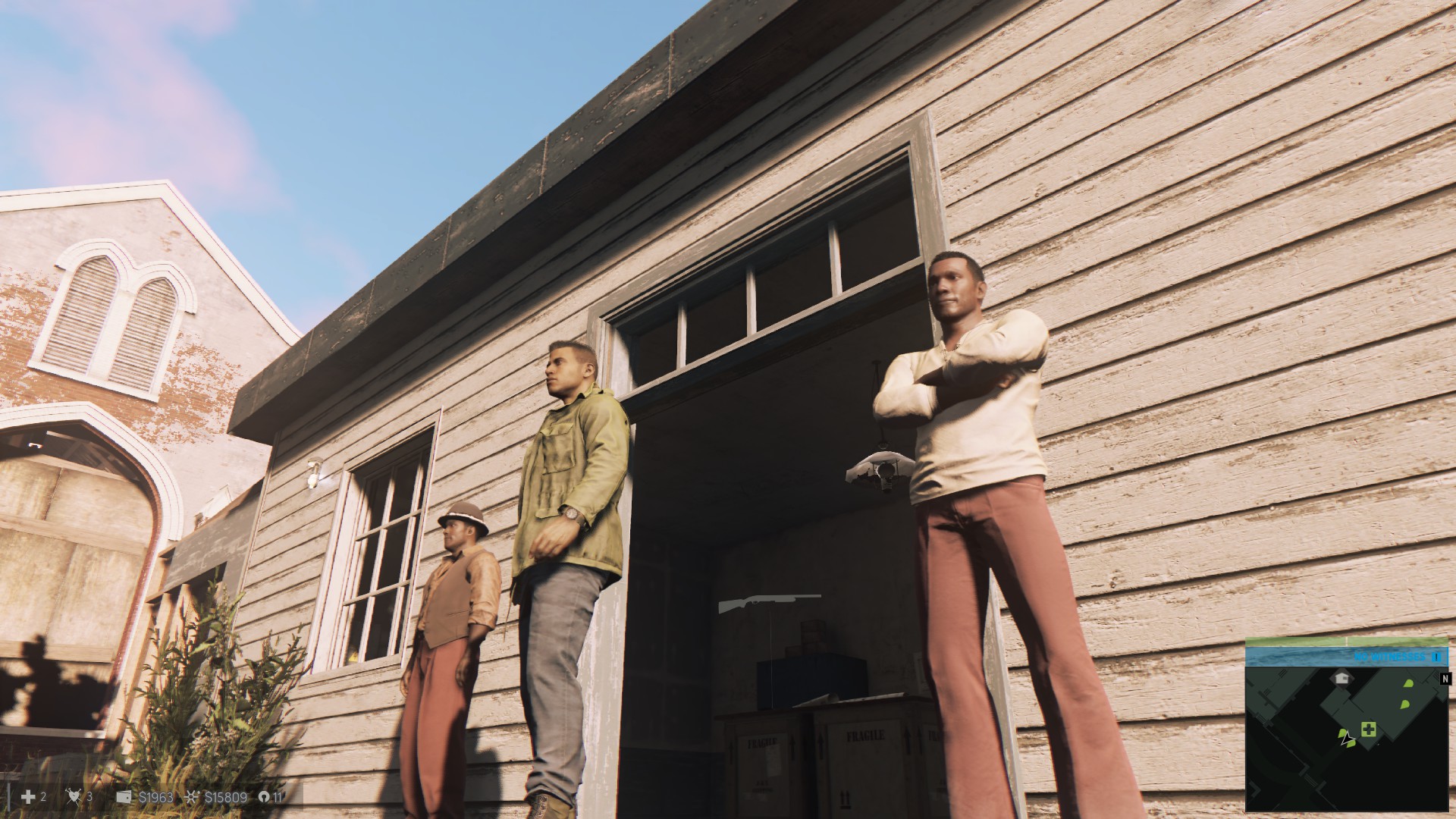
Sometimes, “havoc” means location-specific stuff like busting up liquor shops or blowing up construction cranes. More often than not, it involves killing a whole mess of people in interchangeable locations. You get a target, you stalk through a cover-strewn area stabbing and shooting, and then you take out that target — or, if you’re feeling charitable, twist their arm until they join your cause.
It actually reminds me a bit of Shadow of Mordor, although sadly without the fantastic Nemesis System. When you reclaim territories from other mob groups, you hand them over to your underbosses, all of whom are fleshed out characters with their own goals. They can even turn on you if you neglect any one of them for too long.
It’s fun and satisfying, albeit fairly simplistic and repetitive on a moment-to-moment level. It’s also jankier than an old jalopy: Enemy AI vacillates wildly between barely acceptable and laughably incompetent, and you can always whistle to make them walk to Clay’s position like idiot zombie dogs, at which point you can press a single button to pop out from behind cover, stab them in the neck, and then drag them out of sight.
It’s an ability that’s as silly as it is overpowered. Enemies also regularly fail to take cover, see you from inches away, or avoid other cars while driving. To them, self-preservation is merely a suggestion, if even that.
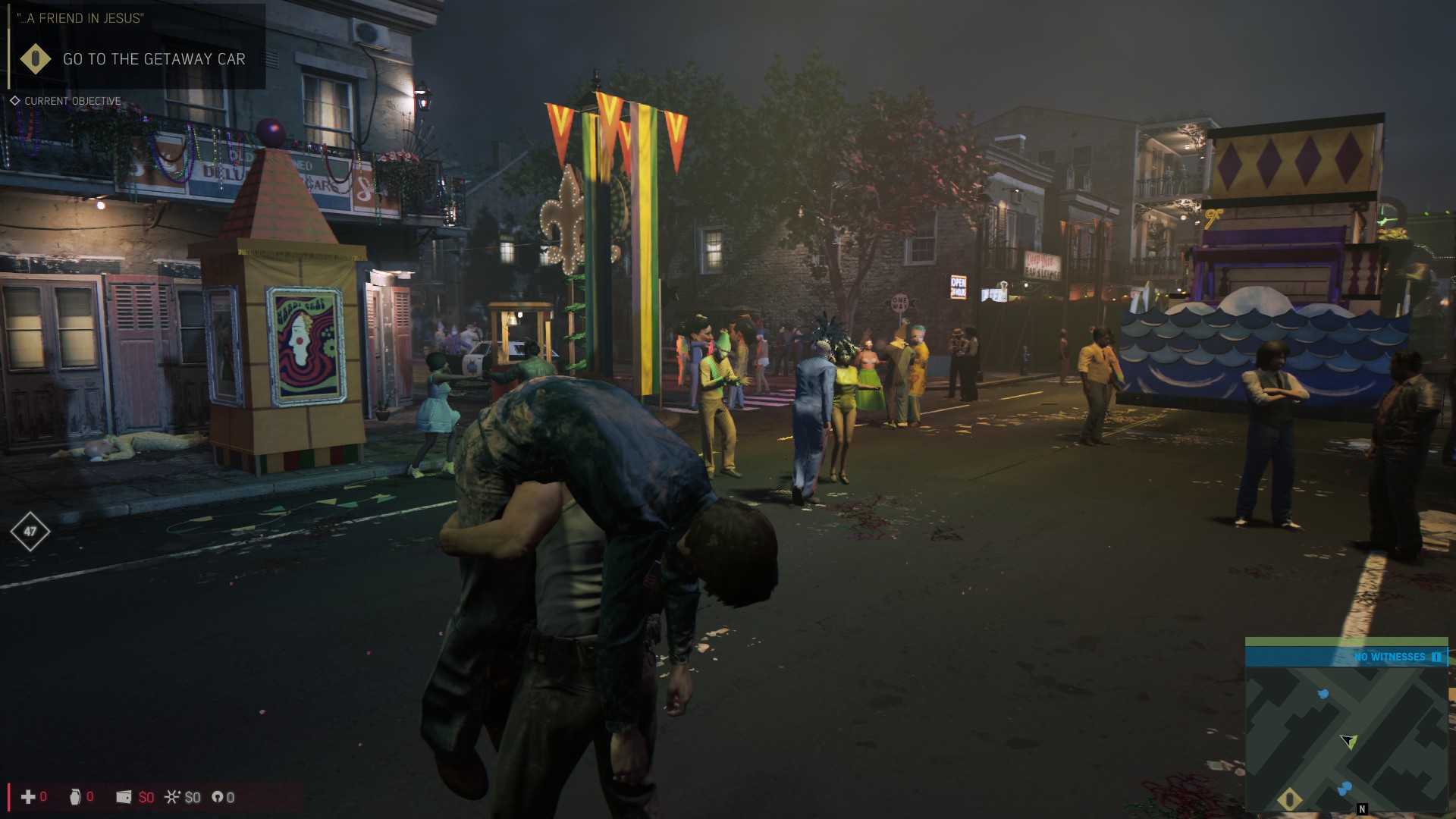
Civilian NPCs aren’t much better. They drive like idiots (often to your detriment during car chases), amble aimlessly around town, and frequently fail to react when you snap somebody’s neck in front of them. As easy as it is to get wrapped up in New Bordeaux’s excellent sense of time and place, the game’s AI frequently destroys that illusion. It’s like going through the “It’s A Small World” ride at Disneyland. Everything is so lively and animated, but you see all the empty eyes. No matter how hard you try, you’re never fully under the spell.
Somehow, though, stalking and shooting your way through offices, alleys, garages, sewers, swamps, construction sites, and — in one case — a spooky theme park is still pretty fun. You’re almost always outnumbered and outgunned, but you can approach most situations however you want by way of multiple entrances, climbing, and unlockable abilities like distractions and calling for backup.
It’s devilishly satisfying to repeatedly outsmart armies of dumb jamokes. A whistle here, a well-placed sniper shot there, a molotov cocktail on a bunch of guys who are still firing at the cover you hid behind when you whistled. You start to feel unstoppable. Yes, it’s wildly repetitive, but it’s fun repetition that feels good. You go to places, you get a dose of adrenaline, and then you just drive for a while. You drive and breathe.
The game’s world and structure bolster this. New Bordeaux is massive, filled with slums, metropolitan meccas, and swamps. It’s a joy to explore, especially given the fact that it’s severely lacking in random distractions compared to other modern open-world games. There are not a million things to collect, nor are there an overwhelming number of side missions. What’s there is manageable and largely tied to the main story. It’s a refreshing break from the content overload of other open-world games. It’s a game that encourages you to explore for exploration’s sake, even if most of those explorations end in bloodshed.
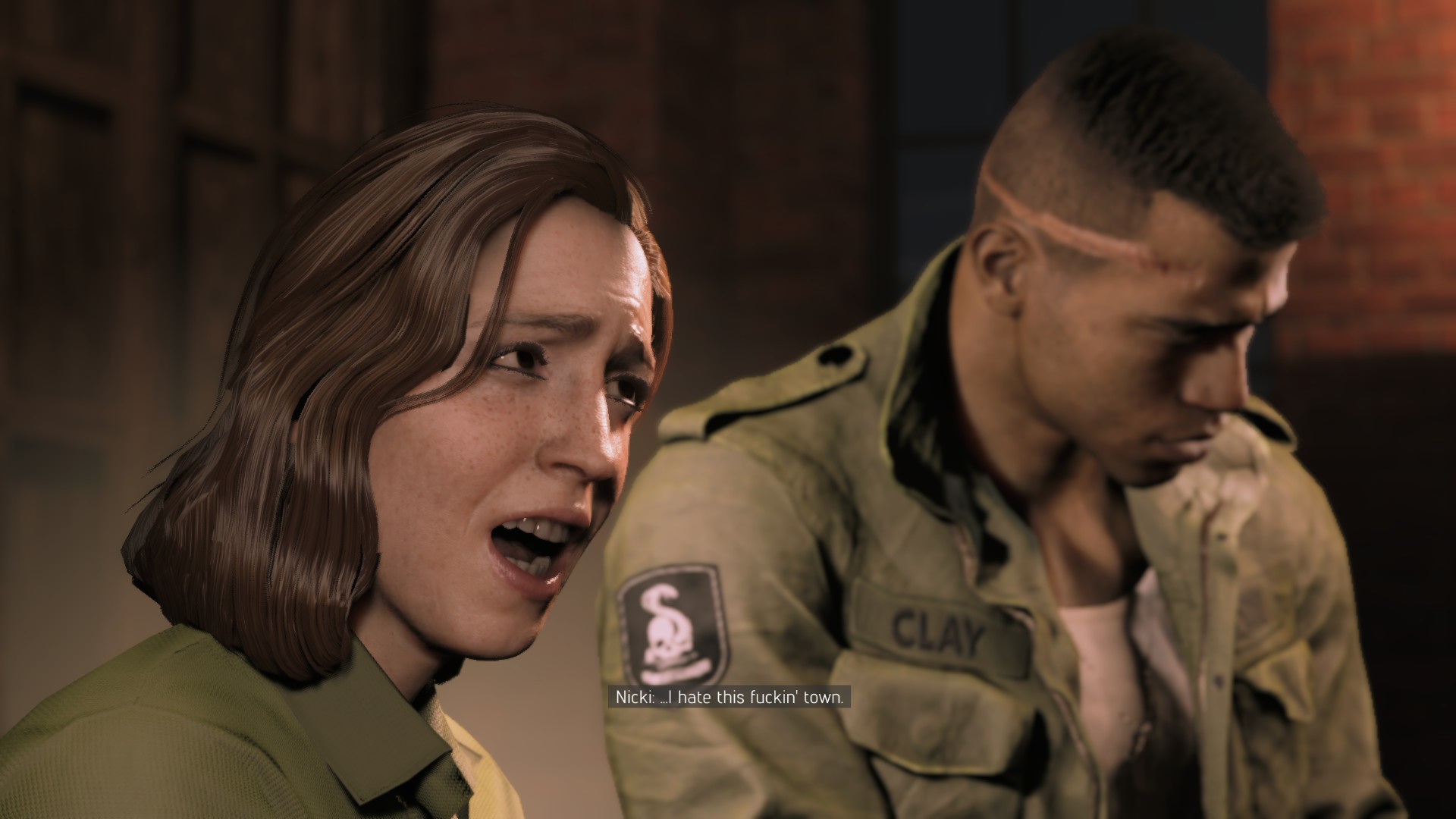
Writing is one of Mafia III’s strong points, and it really brings these different areas and events to life. One time, while skulking through a warehouse, I heard a couple Dixie mafia arseholes saying they were going to reclaim the Hollows neighbourhood and put “those uppity negroes” back in their place. They were having such a great time being awful old racists that they barely even noticed when I ran them over with their own Confederate-flag-emblazoned truck.
Another time, I was casing a heavily guarded butcher shop (used for torture, naturally), and I overheard a couple Italian mob goons mourning the loss of an underboss I’d recently killed. They enjoyed working for him, they said. He was a decent guy, and he had a nice family. Just before they resumed their patrols, one somberly noted, “We’ve had too many tombstones lately.” “Whoops,” I said to myself. “My bad.”
Was it all a bit heavy-handed? Sure. But when you’re drunk on power after mowing down yet another horde of faceless goons, moments like that are surprising. They snap you back into reality, if only for a second.
That’s Mafia III’s greatest strength: it provides brief glimpses of humanity amidst a near-constant stream of carnage. Main character Lincoln Clay is probably the best example of this. He is, in many ways, a prototypical video game hero. He lost his family. He wants revenge. He’s really good at war. He has no qualms about murdering hundreds of people. For the first five or so hours of the story, it seems like the game is just going to play that straight. Clay’s a Vietnam vet with a heart of gold who also murders 2.23 people per minute and props up multiple organised crime organisations that grievously harm good people. Sure! No moral quandaries here!
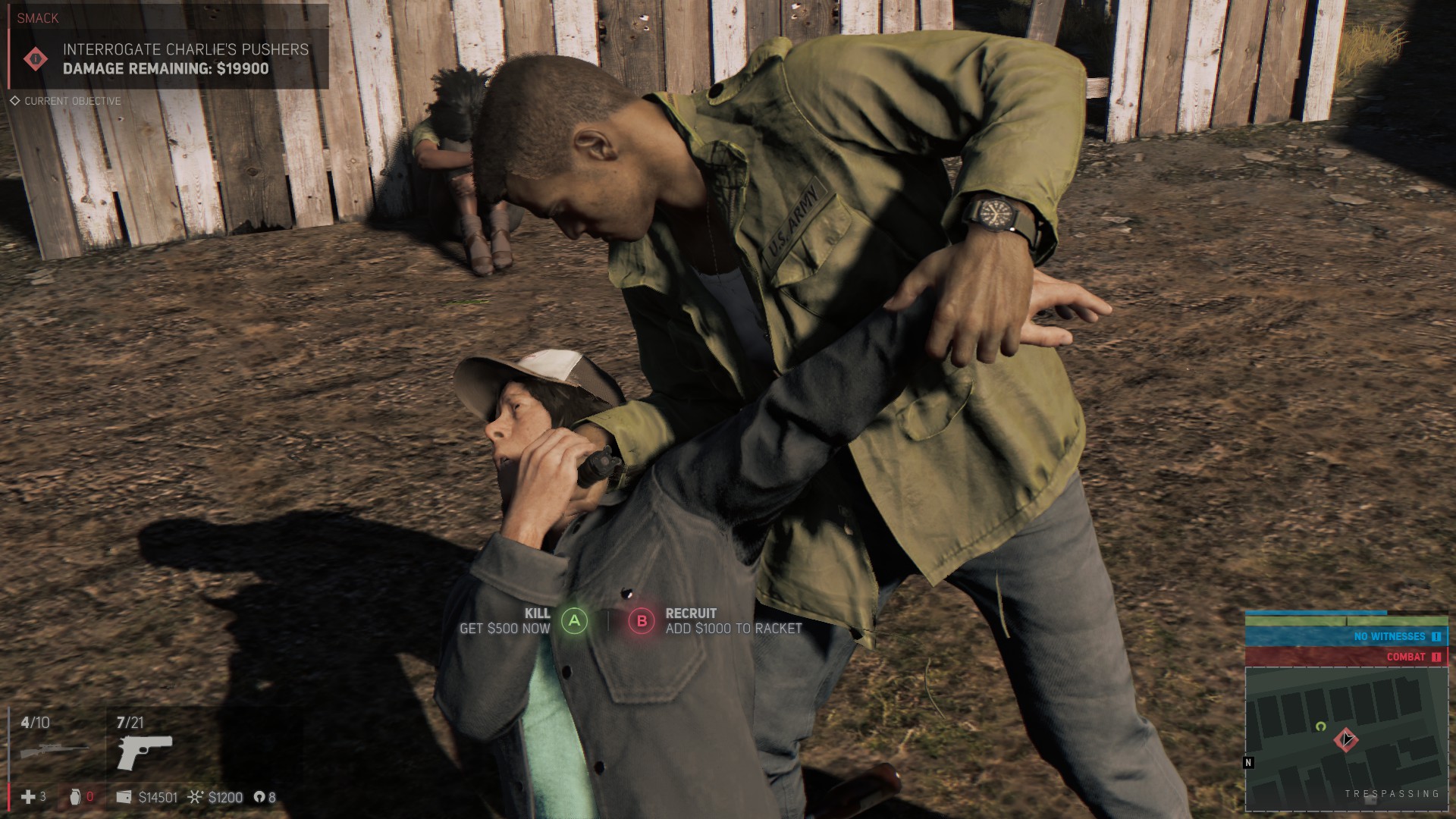
Slowly but surely, however, the game deconstructs that persona. It pokes and prods at Clay’s grim determination. It challenges him. At one point, Clay is talking with his adoptive uncle and only surviving “family” member, a priest named Father James, about his mission. James can’t believe how much destruction Clay has caused in the name of bringing down one man. He says he remembers when Clay was a kid, one who dealt with loss, hardship, and abject cruelty but remained kind and compassionate. He asks Clay where that person went.
“He finally realised how things work,” Clay replies. James retorts that even when “racist arseholes” vandalised Clay’s childhood orphanage and made life difficult — when the system kept him and other orphans poor and begging — good people came around and helped. “White, black, Baptists, Lutheran — you name it,” James says. “If all you ever look for is evil, it’s all you’re ever going to see.”
At another point, he gets confronted by Cassandra, the head of the Haitian mob and one of his most powerful allies. She asks for weapons to arm her people, most of whom are black. Clay says he’s not here to start a revolution. Cassandra angrily asks if Clay understands what he’s doing by slaughtering everybody he can get his hands on, what the white people in power see when he does.
“I don’t give a shit one way or another,” says Clay. “They can come after me.” “And what happens when you not around, and another black man or woman is?” Cassandra asks. “We all the same to them.” It’s a bullshit situation, of course. No single person should have to bear that burden. But it is, to quote Clay, “how things work.” When a community is oppressed, crime naturally follows. But ultimately, said community usually suffers most from that crime.
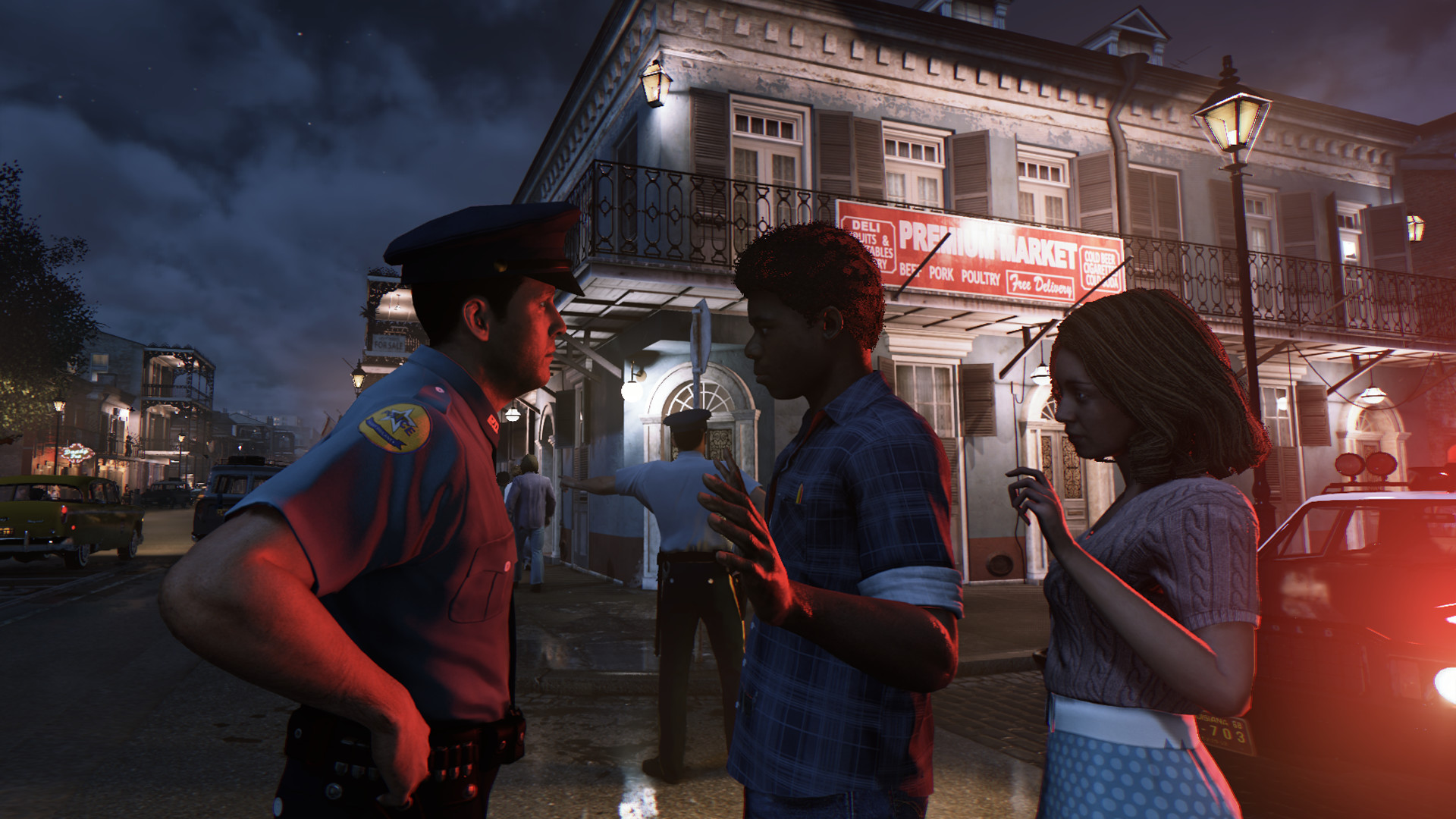
Clay’s struggle is with his own place in a world he views — justifiably, given what he’s been through and seen — through a deeply nihilistic lens. It’s an understandable, remarkably relevant struggle — the sort that rarely gets presented in video games, triple-A or otherwise. The game drives it home systemically. Many stores and restaurants are segregated. Police dispatches to poor, majority-black neighbourhoods are peppered with language like, “If there’s a unit in the area, maybe stop over and see what’s going on.” In rich white areas, however, they react with all the urgency in the world. No matter where you are, cops stare at you and sometimes come after you for tiny infractions. One second, a mission is going great. The next, cops are everywhere, and you’re at death’s door. It’s frustrating. It’s unfair. It’s racism.
At the same time, though, you can still speed down streets with reckless abandon and engage in typical open-world power fantasy behaviour. In that respect, the game is at odds with itself. Mafia III does more to depict racism and oppression than any triple-A venture I can think of, but over-the-top action still comes first.
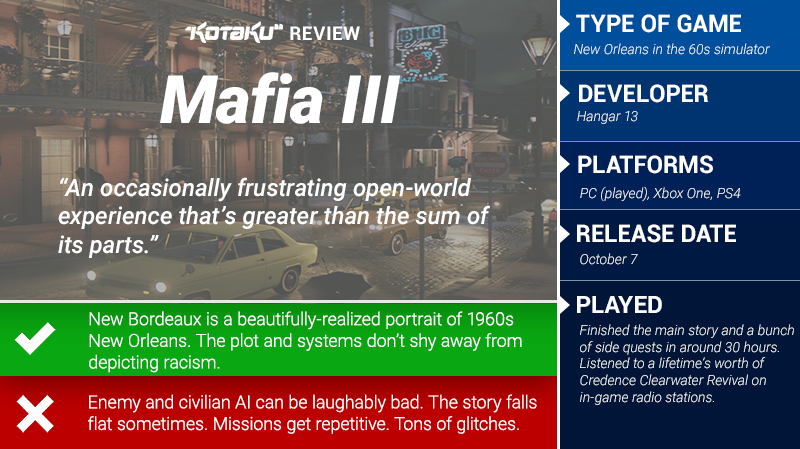
Like the rest of Mafia III, the story of Clay and his allies is flawed and sometimes ugly. It misses the mark in a handful of ways both big and small, and it tries to walk a line somewhere between pulp action, serious drama, classic gangster flick, and stylish HBO show. Tonally, it never quite figures out what it wants to be. Sometimes the story also disappears for long stretches, giving way to a barebones presentation and generic open-world crime antics. These sections feel almost unfinished. Devoid of even Mafia II’s level of variety, that’s when the game is at its absolute weakest.
But Mafia III’s story is often told with impressive subtlety and personality, despite occasionally being prone to cringe-worthy clumsiness. Everybody’s struggling with the burden of some kind of loss, some kind of violence. Most of them know inflicting more violence won’t make them whole again, but they do it anyway. It’s all they feel like they can do. Some characters take a while to reveal what they’re all about, but it’s damn rewarding when they do.
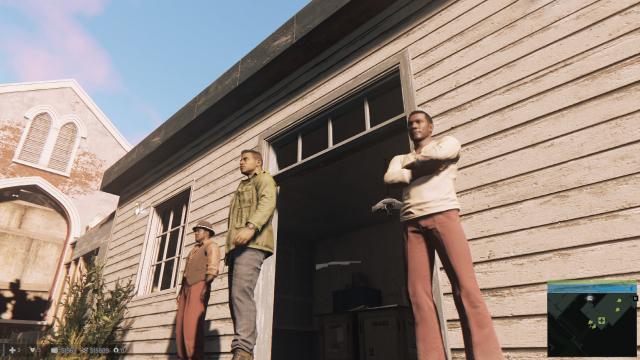
Comments
3 responses to “Mafia III: The Kotaku Review”
Game has an awesome story. Most of the mob bosses are cool to take out. I wouldn’t recommend buying it, I’ve finished it and traded it in for Rise of the Tomb Raider.
My biggest gripe with this game is All Along the Watchtower plays at the title screen and not in the fucking game, I heard there was a ton of licensed music more than once, there is but its not enough.
Also traded in for tomb raider. Much happier with now.
ive been unable to motivate myself to finish it, it started good (minus the the bullshit 30fps lock and the constant crashing) story wise but after 19hrs and having only just completed the very first sit down after taking the 3 starting districts for your underbosses, the story missions have just come through far to slowly.
Its also very shitty that nothing you do counts at all until you speak to your informants and its also stupid that i can break into a shop in a white neighberhood in clear view of other civilians and they wont bat an eye lid.
You had me at “not a lot of side stuff”.